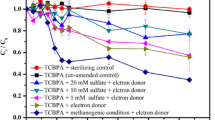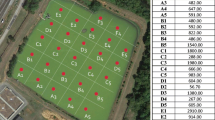Abstract
Several groups of bacteria such as Dehalococcoides spp., Dehalobacter spp., Desulfomonile spp., Desulfuromonas spp., or Desulfitobacterium spp. are able to dehalogenate chlorinated pollutants such as chloroethenes, chlorobenzenes, or polychlorinated biphenyls under anaerobic conditions. In order to assess the dechlorination potential in Yangtze sediment samples, the presence and activity of the reductively dechlorinating bacteria were studied in anaerobic batch tests. Eighteen sediment samples were taken in the Three Gorges Reservoir catchment area of the Yangtze River, including the tributaries Jialing River, Daning River, and Xiangxi River. Polymerase chain reaction analysis indicated the presence of dechlorinating bacteria in most samples, with varying dechlorinating microbial community compositions at different sampling locations. Subsequently, anaerobic reductive dechlorination of tetrachloroethene (PCE) was tested after the addition of electron donors. Most cultures dechlorinated PCE completely to ethene via cis-dichloroethene (cis-DCE) or trans-dichloroethene. Dehalogenating activity corresponded to increasing numbers of Dehalobacter spp., Desulfomonile spp., Desulfitobacterium spp., or Dehalococcoides spp. If no bacteria of the genus Dehalococcoides spp. were present in the sediment, reductive dechlorination stopped at cis-DCE. Our results demonstrate the presence of viable dechlorinating bacteria in Yangtze samples, indicating their relevance for pollutant turnover.




Similar content being viewed by others
References
Aktaş Ö, Schmidt KR, Mungenast S, Stoll C, Tiehm A (2012) Effect of chloroethene concentrations and granular activated carbon on reductive dechlorination rates and growth of Dehalococcoides spp. Biores Technol 103:286–292. doi:10.1016/j.biortech.2011.09.119
Barber JL, Sweetman AJ, van Wijk D, Jones KC (2005) Hexachlorobenzene in the global environment: emissions, levels, distribution, trends and processes. Sci Total Environ 349:1–44. doi:10.1016/j.scitotenv.2005.03.014
Bedard DL (2008) A case study for microbial biodegradation: anaerobic bacterial reductive dechlorination of polychlorinated biphenyls-from sediment to defined medium. Annu Rev Microbiol 62:253–270. doi:10.1146/annurev.micro.62.081307.162733
Behrens S, Azizian MF, McMurdie PJ, Sabalowsky A, Dolan M, Semprini L, Spormann AM (2008) Monitoring abundance and expression of Dehalococcoides species chloroethene-reductive dehalogenases in a tetrachloroethene-dechlorinating flow column. Appl Environ Microb 74:5695–5703. doi:10.1128/AEM.00926-08
Bergmann A, Bi Y, Chen L, Floehr T, Henkelmann B, Holbach A et al (2012) The Yangtze-Hydro Project: a Chinese-German environmental program. Environ Sci Poll Res 19:1341–1344. doi:10.1007/s11356-011-0645-7
Cheng D, He J (2009) Isolation and characterization of Dehalococcoides sp. strain MB, which dechlorinates tetrachloroethene to trans-1,2-dichloroethene. Appl Environ Microb 75:5910–5918. doi:10.1128/AEM.00767-09
Cheng D, Chow WL, He J (2009) A Dehalococcoides-containing co-culture that dechlorinates tetrachloroethene to trans-1,2-dichloroethene. ISME J 4:88–97. doi:10.1038/ismej.2009.90
Chow WL, Cheng D, Wang S, He J (2010) Identification and transcriptional analysis of trans-DCE-producing reductive dehalogenases in Dehalococcoides species. ISME J 4:1020–1030. doi:10.1038/ismej.2010.27
El Fantroussi S, Mahillon J, Naveau H, Agathos SN (1997) Introduction of anaerobic dechlorinating bacteria into soil slurry microcosms and nested-PCR monitoring. Appl Environ Microb 63:806–811
Field JA, Sierra-Alvarez R (2008) Microbial degradation of chlorinated benzenes. Biodegradation 19:463–480. doi:10.1007/510532-007-9155-1
Griffin BM, Tiedje JM, Löffler FE (2004) Anaerobic microbial reductive dechlorination of tetrachloroethene to predominately trans-1,2-dichloroethene. Environ Sci Technol 38:4300–4303. doi:10.1021/es035439g
Grostern A, Edwards EA (2006) Growth of Dehalobacter and Dehalococcoides spp. during degradation of chlorinated ethanes. Appl Environ Microb 72:428–436. doi:10.1128/AEM.72.1.428-436.2006
Hendrickson ER, Payne JA, Young RM, Starr MG, Perry MP, Fahnestock S et al (2002) Molecular analysis of Dehalococcoides 16S ribosomal DNA from chloroethene-contaminated sites throughout North America and Europe. Appl Environ Microb 68:485–495. doi:10.1128/AEM.68.2.485-495.2002
Holliger C, Schraa G, Stams AJ, Zehnder AJ (1993) A highly purified enrichment culture couples the reductive dechlorination of tetrachloroethene to growth. Appl Environ Microb 59:2991–2997
Holliger C, Wohlfarth G, Diekert G (1999) Reductive dechlorination in the energy metabolism of anaerobic bacteria. FEMS Microbiol Rev 22:383–398. doi:10.1111/j.1574-6976.1998.tb00377.x
Jiang X, Martens D, Schramm KW, Kettrup A, Xu SF, Wang LS (2000) Polychlorinated organic compounds (PCOCs) in waters, suspended solids and sediments of the Yangtse River. Chemosphere 41:901–905. doi:10.1016/s00456535(99)00435-x
Kittelmann S, Friedrich MW (2008) Novel uncultured Chloroflexi dechlorinate perchloroethene to trans-dichloroethene in tidal flat sediments. Environ Microbiol 10:1557–1570. doi:10.1111/j.1462-2920.2008.0157.x
Kranzioch I, Tiehm A (2012) Assessment of pollutant biodegradation at the Yangtze Three Gorges Dam, China. Int J Water Management “blue facts” 2012:70–77
Liu H, Zhou Q, Wang Y, Zhang Q, Cai Z, Jiang G (2008) E-waste recycling induced polybrominated diphenyl ethers, polychlorinated biphenyls, polychlorinated dibenzo-p-dioxins and dibenzo-furans pollution in the ambient environment. Environ Int 34:67–72. doi:10.1016/j.envint.2007.07.008
Löffler FE, Sun Q, Li J, Tiedje JM (2000) 16S rRNA gene-based detection of tetrachloroethene-dechlorinating Desulfuromonas and Dehalococcoides species. Appl Environ Microb 66:1369–1374. doi:10.1128/AEM.66.4.1369.1374.2000
Löffler FE, Yan J, Ritalahti KM, Adrian L, Edwards EA, Konstantinidis KT et al (2012) Dehalococcoides mccartyi gen. nov., sp. nov., obligate organohalide-respiring anaerobic bacteria, relevant to halogen cycling and bioremediation, belong to a novel bacterial class, Dehalococcoidetes classis nov., within the phylum Chloroflexi. Int J Syst Evol Microbiol. doi:10.1099/ijs.0.034926-0
Lohner ST, Tiehm A (2009) Application of electrolysis to stimulate microbial reductive PCE dechlorination and oxidative VC biodegradation. Environ Sci Technol 43:7098–7104. doi:10.1021/es900835d
Lohner ST, Becker D, Mangold K-M, Tiehm A (2011) Sequential reductive and oxidative biodegradation of chloroethenes stimulated in a coupled bioelectro-process. Environ Sci Technol 45:6491–6497. doi:10.1021/es200801r
Maphosa F, de Vos WM, Smidt H (2010) Exploiting the ecogenomics toolbox for environmental diagnostics of organohalide-respiring bacteria. Trends Biotechnol 28:308–316. doi:10.1016/j.tibtech.2010.03.005
Marco-Urrea E, Nijenhuis I, Adrian L (2011) Transformation and carbon isotope fractionation of tetra- and trichloroethene to trans-dichloroethene by Dehalococcoides sp. strain CBDB1. Environ Sci Technol 45:1555–1562. doi:10.1021/es1023459
Maymó-Gatell X, Nijenhuis I, Zinder SH (2001) Reductive dechlorination of cis-1,2-dichloroethene and vinyl chloride by Dehalococcoides ethenogenes. Environ Sci Technol 35:516–521. doi:10.1021/es001285i
Müller B, Berg M, Yao ZP, Zhang XF, Wang D, Pfluger A (2008) How polluted is the Yangtze river? Water quality downstream from the Three Gorges Dam. Sci Total Environ 402:232–247. doi:10.1016/j.scitotenv.2008.04.049
Ritalahti KM, Löffler FE, Rasch EE, Koenigsberg SS (2005) Bioaugmentation for chlorinated ethene detoxification: bioaugmentation and molecular diagnostics in the bioremediation of chlorinated ethene-contaminated sites. Ind Biot 1:114–118. doi:10.1089/ind.2005.1.114
Rouzeau-Szynalski K, Maillard J, Holliger C (2011) Frequent concomitant presence of Desulfitobacterium spp. and Dehalococcoides spp. in chloroethene-dechlorinating microbial communities. Appl Microbiol Biot 90:361–368. doi:10.1007/s00253-010-3042-0
Schmidt KR, Tiehm A (2008) Natural attenuation of chloroethenes: identification of sequential reductive/oxidative biodegradation by microcosm studies. Water Sci Technol 58:1137–1145. doi:10.2166/wst.2008.729
Schmidt KR, Stoll C, Tiehm A (2006) Evaluation of 16S-PCR detection of Dehalococcoides at two chloroethene-contaminated sites. Water Sci Technol 6:129–136. doi:10.2166/ws.2006.787
Schmidt KR, Augenstein T, Heidinger M, Ertl S, Tiehm A (2010) Aerobic biodegradation of cis-1,2-dichloroethene as sole carbon source: stable carbon isotope fractionation and growth characteristics. Chemosphere 78:527–532. doi:10.1016/j.chemosphere.2009.11.033
Shen C, Tang X, Cheema SA, Zhang C, Khan MI, Liang F et al (2009) Enhanced phytoremediation potential of polychlorinated biphenyl contaminated soil from e-waste recycling area in the presence of randomly methylated-beta-cyclodextrins. J Hazard Mater 172:1671–1676. doi:10.1016/j.jhazmat.2009.08.064
Smidt H, de Vos WM (2004) Anaerobic microbial dehalogenation. Annu Rev Microbiol 58:43–73. doi:10.1146/annurev.micro.58.030603.123600
Smits THM, Devenoges C, Szynalski K, Maillard J, Holliger C (2004) Development of a real-time PCR method for quantification of the three genera Dehalobacter, Dehalococcoides, and Desulfitobacterium in microbial communities. J Microbiol Meth 57:369–378. doi:10.1016/j.mimet.2004.02.003
Taş N, van Eekert MHA, Wagner A, Schraa G, de Vos WM, Smidt H (2011) Role of Dehalococcoides spp. in the anaerobic transformation of hexachlorobenzene in European rivers. Appl Environ Microbiol 77:4437–4445. doi:10.1128/AEM.01940-10
Tiehm A, Schmidt KR (2011) Sequential anaerobic/aerobic biodegradation of chloroethenes-aspects of field application. Curr Opin Biotech 22:415–421. doi:10.1016/j.copbio.2011.02.003
Tiehm A, Schmidt KR, Pfeifer B, Heidinger M, Ertl S (2008) Growth kinetics and stable carbon isotope fractionation during aerobic degradation of cis-1,2-dichloroethene and vinyl chloride. Water Res 42:2431–2438. doi:10.1016/j.watres.2008.01.029
Vancheeswaran S, Hyman MR, Semprini L (1999) Anaerobic biotransformation of trichlorofluoroethene in groundwater microcosms. Environ Sci Technol 33:2040–2045. doi:10.1021/es9811952
Wang J, Bi Y, Pfister G, Henkelmann B, Zhu K, Schramm KW (2009) Determination of PAH, PCB, and OCP in water from the Three Gorges Reservoir accumulated by semipermeable membrane devices (SPMD). Chemosphere 75:1119–1127. doi:10.1016/j.chemosphere.2009.01.016
Zhang J (1995) Geochemistry of trace metals from Chinese river/estuary systems: an overview. Estuar Coast Shelf S 41:631–658. doi:10.1006/ecss.1995.0082
Zhao HP, Schmidt KR, Tiehm A (2010) Inhibition of aerobic metabolic cis-1,2-di-chloroethene biodegradation by other chloroethenes. Water Res 44:2276–2282. doi:10.1016/j.watres.2009.12.023
Zhao HP, Schmidt KR, Lohner S, Tiehm A (2011) Robustness of an aerobic metabolically vinyl chloride degrading bacterial enrichment culture. Water Sci Technol 64:1796–1803. doi:10.2166/wst.2011.752
Acknowledgments
The authors gratefully acknowledge the financial support from the German Ministry of Education and Research (BMBF, grant no.: 02WT1130). This study is part of the Sino-German Yangtze-Hydro Project (www.yangtze-project.de).
Author information
Authors and Affiliations
Corresponding author
Additional information
Responsible editor: Robert Duran
Electronic supplementary material
Below is the link to the electronic supplementary material.
ESM 1
(DOC 1616 kb)
Rights and permissions
About this article
Cite this article
Kranzioch, I., Stoll, C., Holbach, A. et al. Dechlorination and organohalide-respiring bacteria dynamics in sediment samples of the Yangtze Three Gorges Reservoir. Environ Sci Pollut Res 20, 7046–7056 (2013). https://doi.org/10.1007/s11356-013-1545-9
Received:
Accepted:
Published:
Issue Date:
DOI: https://doi.org/10.1007/s11356-013-1545-9




